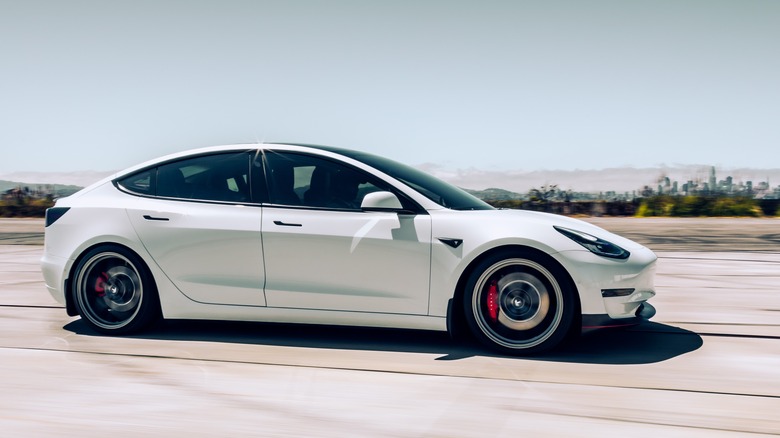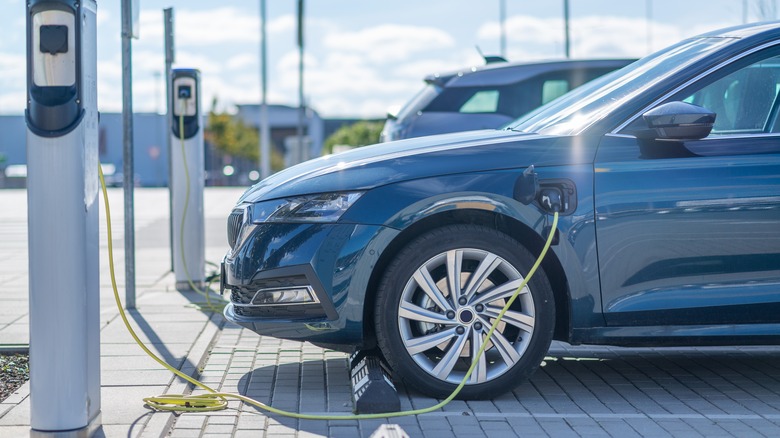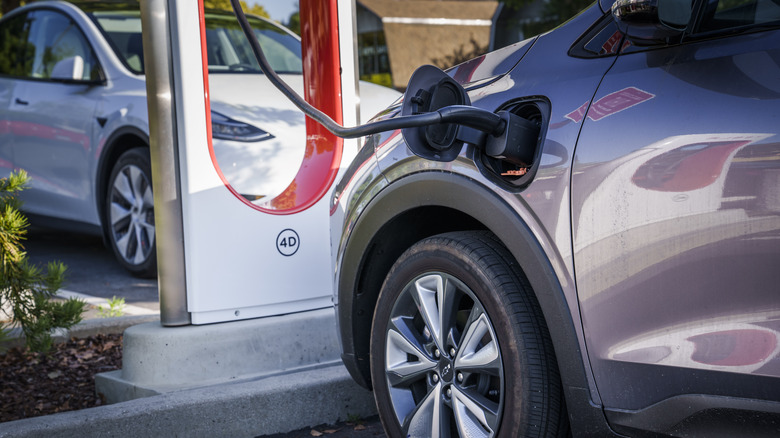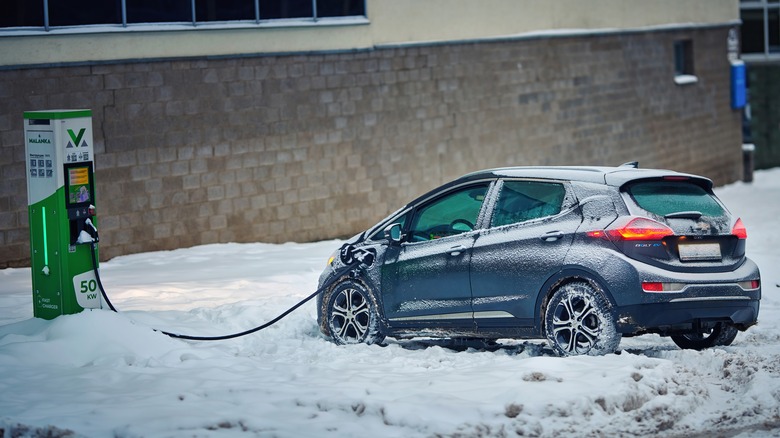6 Things You Need To Know Before Buying A Cheap Electric Car
Affordable electric cars have the potential to change individual transportation, though there are a few important facts and caveats to bear in mind as you pick a cheap EV. It's no surprise that many drivers are considering going electric in the next few years. After all, the appeal of never pumping gas again, getting to use the ride-share lanes in certain U.S. states, and knowing that you're not emitting gases that contribute to climate change is considerable.
While many automakers have been highlighting the outrageous speed of their electric cars (we're looking at you, Tesla), the ridiculous road presence (yes, Hummer EV, we've not forgotten about you either), or just the sheer, luxurious excess (hey, Rolls-Royce Spectre, has your mascot lost weight?), for most, an EV is far less melodramatic. Price, charging, range, and year-round performance are all key concerns, particularly when you're shopping at the more affordable end of the scale.
The good news is, there are some surprisingly low-cost electric cars out there. What's important, though, is to stay aware of what compromises might be involved in order to reduce that overall sticker shock.
Range may not be the dealbreaker you think it is
If there's a bogeyman in the electric vehicle world, it has to be range. After all, when you're used to the convenience of pulling in at any gas station and topping up the tank in five minutes or less, it's perhaps understandable that the thought of needing to find an outlet after a couple of hundred miles of driving causes anxiety. The reality is, though, that range isn't necessarily the barrier to going EV that you might think it is.
Today, there are EVs on the market that are rated to go more than 500 miles on a single charge, though you'll pay handsomely for that grand touring ability. Down at the budget end of the electric category, battery sizes and range estimates tend to be a lot more conservative. Nonetheless, it's worth doing the math on just what driving you'll actually be doing.
The average American driver uses their vehicle for less than 40 miles of driving each day, according to the U.S. Department of Transportation. That means a Chevrolet Bolt EV — which starts at $26,500 (plus destination) and is EPA rated for 259 miles on a single charge — could go about a week before it needed to be plugged in again. According to Bloomberg research, the average electric car sold in the U.S. in 2022 could do 291 miles on a full battery.
Yes, some drivers will be outliers, driving much further on any average day, but for many, it seems likely that they're overestimating just how far they'll need to go between charges.
You can feel good about skipping the bigger wheels
It's a fact of automotive design that most cars look better when they're riding on bigger wheels. Automakers understand that, and so typically if you want larger rims then you'll have to spend more money. However, EV shoppers on a budget have a genuine reason to feel good about getting the smaller wheels.
The most obvious factor is economy. Bigger, wider wheels are less efficient than smaller, narrower wheels: they're heavier, and require more energy to get them turning as they have more resistance. It's the case for internal combustion vehicles, too, only the impact is often more noticeable on an EV where you're eagle-eyed about remaining range.
Take the Kia EV6, for example. In Long Range, All-Wheel Drive form, with 19-inch wheels, it's EPA rated for 282 miles of range from its 77.4 kWh battery. Switch to the larger 20-inch wheels, though, and that total range estimate dips to 252 miles.
Then there's the comfort factor. On those two different sizes of Kia EV6 wheels, for instance, the 19-inch wheels sport 235/55R19 tires, while the 20-inch wheels get 255/45R20 tires: the smaller wheels have more tire sidewall. That can mean they're more compliant, increasing ride comfort. It's of particular benefit on electric cars, which often have stiffer suspension because of their relatively high curb weight (those battery packs are heavy).
Some cheap EVs get even cheaper with subsidies and incentives
The incentives, credits, and rebates available on new electric vehicles can be confusing. The federal tax credit for EVs is the most significant: reworked as part of the U.S. Inflation Reduction Act of 2022, the credit now takes into account the cost of the vehicle (including any options), where the EV was constructed, and where the battery was assembled. That has had the impact of bringing some previously-unqualified EVs back into contention, but also leaves some of the most popular models out in the cold, too.
A Chevrolet Bolt EV or Bolt EUV, for example, now qualifies for up to $7,500 in tax incentives; previously, Chevy's strong sales of the EV had counted it out of that credit. A base Ford Mustang Mach-E, with the standard range battery, qualifies for $3,750 in incentives, while a base VW ID.4 Standard qualifies for $7,500, as does a Tesla Model 3 Standard Range RWD. However, a Nissan Leaf or a Kia Niro EV don't meet the requirements at all, and so get no incentives currently.
While the most significant, the tax incentive isn't the only potential offset new EV buyers can get. Many U.S. states have discounts and incentives, too, along with electricity companies. Even if they don't help cut the sticker price of your new car, they can sometimes reduce the cost of a home EV charger, or the price of electricity you pay when plugged in. It definitely pays to do your research.
Not all electric cars charge equally fast
If battery capacity is the jug of juice, then charging rate is just how fast you can refill it once it's getting low. Not every EV recharges at the same rate, and the difference can be significant — and make a big impact on how long you're waiting at a public charger. Often — though not always — cheaper electric cars support lower charging rates than more expensive EVs do.
The most commonly quoted number is the so-called DC fast charging rate: the speed at which an EV can accept a charge from a public fast charger. These are usually much faster than any home charger can manage, potentially capable — assuming you find a sufficiently potent public charger, too — of adding 15 to 20 miles of range per minute plugged in.
That potential is measured in kilowatts (kW), and it's here that some more affordable EVs start to lag behind. Chevrolet's Bolt EUV, for instance, has a maximum rate of 55 kW; a Nissan Leaf could manage just over 62 kW. In contrast, a Kia EV6 can handle up to 233 kW, while a Lucid Air tops out at 300 kW. It can make a huge difference to how long you're plugged in. After 30 minutes, for example, a Bolt EUV will have added up to 95 miles of range. A Kia EV6, meanwhile, could have added more than 200 miles of range in less than 20 minutes.
One key feature impacts cold weather range significantly
Electric vehicles have gained a reputation over the years for being unpredictable in cold weather. It's not entirely undeserved: battery performance does drop in cold climates, after all, and that can have a considerable impact on your overall range. Add to that the power-hungry act of turning up the cabin heat, and it's no surprise that some drivers in cold weather states have written off an EV from the outset.
Increasingly, though, we're seeing manufacturers of electric cars offer technologies that actively boost performance in the cold. The most significant of those is probably the heat pump, which is one of those fiendishly complicated things that ends up just seeming magical. In short, though, a heat pump uses similar concepts to how refrigerators get cold, only here it's to warm components in an EV.
Exactly what's warmed can vary, depending on the car: some use the heat pump to raise the cabin temperature, avoiding spending battery power on the traditional heaters. Others use the heat pump output to warm the battery, bringing it into a more efficient temperature range. Regardless, the difference can be meaningful: Polestar, for instance, estimates that its heat pump in the Polestar 2 can improve range by as much as 10%.
Unfortunately, though heat pumps are more common than they once were, they can still be rare on more affordable EVs. Neither the Bolt EV nor Bolt EUV offers one; Nissan's Leaf does, but only on the more expensive SV Plus trim. Similarly, Kia's Niro Electric has a heat pump, but only on higher-end trims. If you live in a cold weather state, it's probably worth spending the extra on the option if it's available.
Our cheap EV options are getting more limited
It's true that we're seeing more and more electric vehicle options reach the market. That pace isn't likely to slow over the next few years, either, as automakers refresh their line-ups and swap out old, internal combustion models for EVs instead. Unfortunately, that doesn't necessarily mean that electric cars are getting that much cheaper.
In fact, some of the most affordable options are set to vanish. Chevrolet already confirmed that the Bolt EV and Bolt EUV are being discontinued, with the production of both sub-$30k models ending at the end of 2023. Nissan hasn't gone quite as far with the Leaf, but it's a fact of the industry right now that bigger, better-equipped, and inevitably more expensive models are where the focus is.
That's great if you want a luxury car that's also zero-emissions, but not such good news if you're a driver on a strict budget. Meanwhile, though some of the price hikes that we saw around used cars during the pandemic have settled again, pre-owned EVs still come with their own share of considerations. Battery health is undoubtedly the biggest headache, though maintenance and repair costs can also be a significant consideration. If a new EV is out of your reach, finding a certified pre-owned model from a dealer with electric vehicle experience is probably the next best thing.






